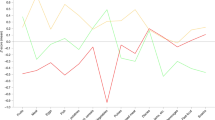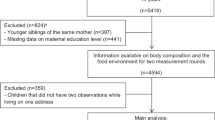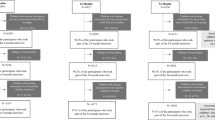Abstract
Objectives:
We investigated the roles of home and school environments on dietary patterns among children from 12 countries differing widely in geographic region and levels of human and economic development.
Methods:
The sample included a total of 6685 (54% girls) 9–11-year-old children. Parents/guardians reported the availability of certain foods in the home, and trained researchers performed school audits recording the availability of foods for sale at schools. Foods were then divided into wholesome (nutrient-dense) and empty-calorie (nutrient-poor) foods and scored according to their availability. Children reported if their school provided school lunch and how many times during the last week they had eaten meals prepared away from home and school. Via principal components analysis, data-driven dietary pattern scores were calculated from food frequency questionnaires. Multilevel models were used to study the associations between home and school food environments (wholesome and empty-calorie foods) and dietary patterns (healthy and unhealthy diet pattern scores).
Results:
For low unhealthy diet pattern scores, low availability of empty-calorie foods at home was found to be more important than high availability of wholesome foods. More meals eaten outside home and school were associated with the higher unhealthy diet pattern scores. The availability of wholesome foods at home was positively associated with the healthy diet pattern scores. Food availability at school was not associated with the dietary patterns.
Conclusions:
In this sample, the home food environment was more significant than the school food environment in predicting the dietary patterns. The availability of empty-calorie foods was associated with the unhealthy dietary pattern even when the availability of wholesome foods at home was high. Meals prepared away from home contributed to the unhealthy dietary pattern. Therefore, parents should be encouraged to limit the availability of empty-calorie foods and eating outside the home.
This is a preview of subscription content, access via your institution
Access options
Subscribe to this journal
We are sorry, but there is no personal subscription option available for your country.
Buy this article
- Purchase on Springer Link
- Instant access to full article PDF
Prices may be subject to local taxes which are calculated during checkout


Similar content being viewed by others
References
O’Flaherty M, Buchan I, Capewell S . Contributions of treatment and lifestyle to declining CVD mortality: why have CVD mortality rates declined so much since the 1960 s? Heart 2013; 99: 159–162.
Lobstein T, Jackson-Leach R, Moodie ML, Hall KD, Gortmaker SL, Swinburn BA et al. Child and adolescent obesity: part of a bigger picture. Lancet 2015; 385: 2510–2520.
Van der Klaauw AA, Farooqi IS . The hunger genes: pathways to obesity. Cell 2015; 161: 119–132.
Eaton NR, Krueger RF, South SC, Gruenewald TL, Seeman TE, Roberts BW . Genes, environments, personality, and successful aging: toward a comprehensive developmental model in later life. J Gerontol A Biol Sci Med Sci 2012; 67: 480–488.
Story M, Kaphingst KM, Robinson-O’Brien R, Glanz K . Creating healthy food and eating environments: policy and environmental approaches. Annu Rev Public Health 2008; 29: 253–272.
Townshend T, Lake AA . Obesogenic urban form: theory, policy and practice. Health Place 2009; 15: 909–916.
Institute of Medicine (US) Committee on Prevention of Obesity in Children and Youth Preventing Childhood Obesity: Health in the Balance. National Institutes of Health: : Washington DC, USA, 2005.
Kelishadi R, Azizi-Soleiman F . Controlling childhood obesity: A systematic review on strategies and challenges. J Res Med Sci 2014; 19: 993–1008.
Engler-Stringer R, Le H, Gerrard A, Muhajarine N . The community and consumer food environment and children’s diet: a systematic review. BMC Public Health 2014; 14: 522.
Caspi CE, Sorensen G, Subramanian SV, Kawachi I . The local food environment and diet: a systematic review. Health Place 2012; 18: 1172–1187.
Williams J, Scarborough P, Matthews A, Cowburn G, Foster C, Roberts N et al. A systematic review of the influence of the retail food environment around schools on obesity-related outcomes. Obes Rev Off J Int Assoc Study Obes 2014; 15: 359–374.
Wang L, Dalton WT, Schetzina KE, Fulton-Robinson H, Holt N, Ho A et al. Home food environment, dietary intake, and weight among overweight and obese children in Southern Appalachia. South Med J 2013; 106: 550–557.
Couch SC, Glanz K, Zhou C, Sallis JF, Saelens BE . Home food environment in relation to children’s diet quality and weight status. J Acad Nutr Diet 2014; 114: 1569–1579.
Østbye T, Malhotra R, Stroo M, Lovelady C, Brouwer R, Zucker N et al. The effect of the home environment on physical activity and dietary intake in preschool children. Int J Obes 2013; 37: 1314–1321.
Mikkilä V, Vepsäläinen H, Saloheimo T, Gonzalez SA, Meisel JD, Gang H et al. An international comparison of dietary patterns in 9—11-year old children. Int J Obes Suppl 2015. (this issue).
Katzmarzyk PT, Barreira TV, Broyles ST, Champagne CM, Chaput J-P, Fogelholm M et al. The International Study of Childhood Obesity, Lifestyle and the Environment (ISCOLE): design and methods. BMC Public Health 2013; 13: 900.
Katzmarzyk P, Barreira T, Broyles S, Champagne C, Chaput J, Fogelholm M et al. Relationships between lifestyle behaviors and obesity in 9-11 year old children: results from a 12-country study. Obesity 2015; 23: 1696–1702.
USDA. Food Groups - ChooseMyPlate.gov. Available at http://www.choosemyplate.gov/food-groups/ (accessed on 11 May 2015).
Saloheimo T, González SA, Erkkola M, Milauskas DM, Meisel JD, Champagne C et al. The reliability and validity of a short food frequency questionnaire among 9-11-year-olds: A multinational study on three middle income and high income countries. Int J Obes Suppl 2015. (this issue).
Kenward MG, Roger JH . Small sample inference for fixed effects from restricted maximum likelihood. Biometrics 1997; 53: 983–997.
Gustafson A, Christian JW, Lewis S, Moore K, Jilcott S . Food venue choice, consumer food environment, but not food venue availability within daily travel patterns are associated with dietary intake among adults, Lexington Kentucky 2011. Nutr J 2013; 12: 17.
Junghans AF, Hooge ITC, Maas J, Evers C, De Ridder DTD . Unadulterated - children and adults’ visual attention to healthy and unhealthy food. Eat Behav 2015; 17: 90–93.
Santiago-Torres M, Adams AK, Carrel AL, LaRowe TL, Schoeller DA . Home food availability, parental dietary intake, and familial eating habits influence the diet quality of urban Hispanic children. Child Obes Print 2014; 10: 408–415.
Van Ansem WJC, Schrijvers CTM, Rodenburg G, van de Mheen D . Is there an association between the home food environment, the local food shopping environment and children’s fruit and vegetable intake? Results from the Dutch INPACT study. Public Health Nutr 2013; 16: 1206–1214.
Torres R, Serrano M, Pérez CM, Palacios C . Physical environment, diet quality, and body weight in a group of 12-year-old children from four public schools in Puerto Rico. P R Health Sci J 2014; 33: 14–21.
Clark EM, Quigg R, Wong JE, Richards R, Black KE, Skidmore PML . Is the food environment surrounding schools associated with the diet quality of adolescents in Otago, New Zealand? Health Place 2014; 30: 78–85.
He M, Tucker P, Irwin JD, Gilliland J, Larsen K, Hess P . Obesogenic neighbourhoods: the impact of neighbourhood restaurants and convenience stores on adolescents’ food consumption behaviours. Public Health Nutr 2012; 15: 2331–2339.
Lachat C, Nago E, Verstraeten R, Roberfroid D, Van Camp J, Kolsteren P . Eating out of home and its association with dietary intake: a systematic review of the evidence. Obes Rev 2012; 13: 329–346.
Hill JL, Olive NC, Waters CN, Estabrooks PA, You W, Zoellner JM . Lack of healthy food options on children’s menus of restaurants in the health-disparate Dan River region of Virginia and North Carolina, 2013. Prev Chronic Dis 2015; 12: E40.
Acknowledgements
We thank the ISCOLE External Advisory Board and the ISCOLE participants and their families who made this study possible. A membership list of the ISCOLE Research Group and External Advisory Board is included in Katzmarzyk et al. (this issue). ISCOLE was funded by The Coca-Cola Company.
Author information
Authors and Affiliations
Consortia
Corresponding author
Ethics declarations
Competing interests
MF has received a research grant from Fazer Finland and has received an honorarium for speaking for Merck. AK has been a member of the Advisory Boards of Dupont and McCain Foods. RK has received a research grant from Abbott Nutrition Research and Development. VMa is a member of the Scientific Advisory Board of Actigraph and has received an honorarium for speaking for The Coca-Cola Company. TO has received an honorarium for speaking for The Coca-Cola Company. The remaining authors declare no conflict of interest.
Rights and permissions
About this article
Cite this article
Vepsäläinen, H., Mikkilä, V., Erkkola, M. et al. Association between home and school food environments and dietary patterns among 9–11-year-old children in 12 countries. Int J Obes Supp 5 (Suppl 2), S66–S73 (2015). https://doi.org/10.1038/ijosup.2015.22
Published:
Issue Date:
DOI: https://doi.org/10.1038/ijosup.2015.22
This article is cited by
-
Association between school-level attributes and weight status of Ghanaian primary school children
BMC Public Health (2019)
-
Consumption habits of school canteen and non-canteen users among Norwegian young adolescents: a mixed method analysis
BMC Pediatrics (2018)
-
A free lunch or a walk back home? The school food environment and dietary behaviours among children and adolescents in Ghana
Food Security (2017)



